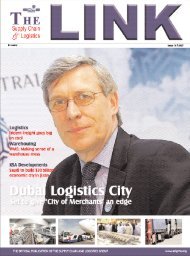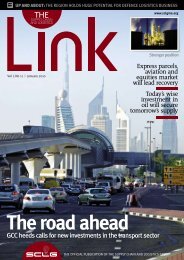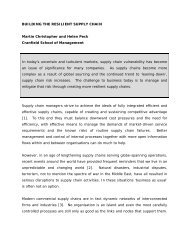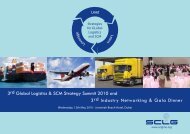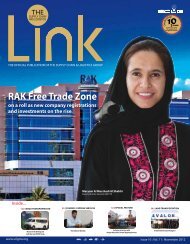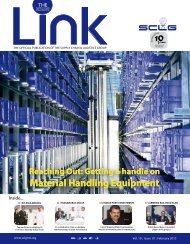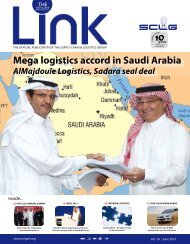Create successful ePaper yourself
Turn your PDF publications into a flip-book with our unique Google optimized e-Paper software.
Current 12 months forward PE versus Five-year High | Source: Financial Dynamics<br />
Extent of fall in forward PE from Five-year High | Source: Financial Dynamics<br />
be closely moni<strong>to</strong>ring those companies,<br />
whose ratings and underpinning financial<br />
metrics rely on assumptions that may no<br />
longer be achievable.”<br />
The rating agency assumes that the<br />
Gulf is “highly interventionist” with regard<br />
<strong>to</strong> the financial health of its flagship<br />
organisations, saying that 94% of all<br />
Moody’s-rated corporate debt in the GCC<br />
is with government-related issuers. The<br />
ratings for these issuers include always<br />
the opinion that government support is<br />
guaranteed in times of crises.<br />
PASSIVE INVESTORS<br />
Aside from the SWFs being passive<br />
long-term inves<strong>to</strong>rs and wanting <strong>to</strong><br />
prioritise investments in their home<br />
economies, the Financial Dynamics (FD)<br />
also said the state-owned funds are<br />
now cautious about supporting further<br />
bailouts of distressed companies. These<br />
funds, however, are set <strong>to</strong> “re-enter<br />
the global equity markets” soon, said<br />
Charles Watson, the company’s group<br />
chief executive officer. He noted that<br />
“compelling valuation propositions” are<br />
emerging across the North American and<br />
Western European equity markets.<br />
“The bot<strong>to</strong>m has yet <strong>to</strong> come,” an FD<br />
study released in February quoted one<br />
SWF executive as saying. “We are ready <strong>to</strong><br />
re-enter the market in a major way – but<br />
not for several months...” said another.<br />
Some funds have even reduced their<br />
exposure <strong>to</strong> the equity markets since 18<br />
months ago, FD said in February. It added<br />
that the executives also emphasised the<br />
need <strong>to</strong> improve corporate governance and<br />
management quality.<br />
A part of FTI Consulting Incorporation,<br />
a global corporate communications<br />
consultancy, FD conducted one-on-one<br />
interviews with senior executives from a<br />
number of the world’s SWFs, whose <strong>to</strong>tal<br />
assets accounted for over 50% of the<br />
$5-trillion worth of collective global funds<br />
held by the SWF asset class.<br />
Released in February, the findings<br />
also showed the majority of the funds<br />
not wanting <strong>to</strong> have majority stakes in<br />
companies or make 100% acquisitions.<br />
“We are increasingly interested in seeing<br />
how it might be possible <strong>to</strong> secure a<br />
cheap entry in<strong>to</strong> an investment either by<br />
buying the debt or structuring some form<br />
of convertible instrument,” said an SWF<br />
executive, “but our intention in doing so<br />
is purely <strong>to</strong> create value, not <strong>to</strong> seek any<br />
form of control.”<br />
PROMISING REGIONS<br />
Asia and South America, especially Brazil,<br />
are the two regions which the SWFs<br />
found <strong>to</strong> be the most attractive, both for<br />
qualitative and quantitative reasons. By<br />
measuring the current price-<strong>to</strong>-earnings<br />
(P/E) ratios of the <strong>to</strong>p 800 companies in<br />
major markets worldwide, and comparing<br />
these valuations <strong>to</strong> market highs, FD<br />
found the “deepest value” in North<br />
America and Western Europe. The P/E ratio<br />
is a measure of the price paid for a share<br />
vis-à-vis the annual profit earned by the<br />
firm per share.<br />
The biggest PE discount relative <strong>to</strong><br />
five-year market high is found in North<br />
America at over -48% and about -47% in<br />
Asia-Pacific. Companies in the Asia-Pacific<br />
fell <strong>to</strong> 13.2% from a high of 25.1%, FD said,<br />
but the market is still expensive, owing<br />
<strong>to</strong> the belief that the region promises<br />
strong economic fundamentals. It added<br />
that various industries, such as media<br />
and entertainment, mining and steel and<br />
other metals are showing the largest <strong>to</strong>p<strong>to</strong>-bot<strong>to</strong>m<br />
falls across all regions.<br />
Despite the current market conditions,<br />
FD said, Western Europe and North<br />
America were named the best investment<br />
regions in financial terms. “Although the<br />
data revealed Asia <strong>to</strong> have one of the<br />
two deepest discount areas alongside<br />
North America,” it added, “its actual P/E<br />
is the highest, and, therefore ... the most<br />
expensive option currently for inves<strong>to</strong>rs.”<br />
The rating agency<br />
assumes that the<br />
Gulf is “highly<br />
interventionist”<br />
with regard <strong>to</strong> the<br />
financial health<br />
of its flagship<br />
organisations,<br />
saying that 94%<br />
of all Moody’srated<br />
corporate<br />
debt in the GCC is<br />
with governmentrelated<br />
issuers. The<br />
ratings for these<br />
issuers include<br />
always the opinion<br />
that government<br />
support is<br />
guaranteed in times<br />
of crises<br />
March 2009 The supply chain and logistics link 33




